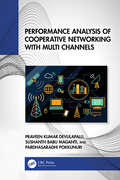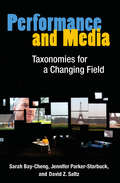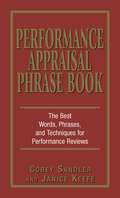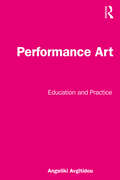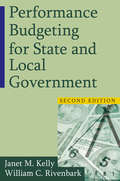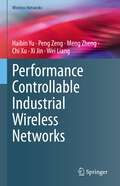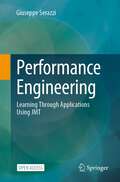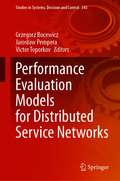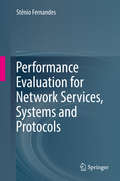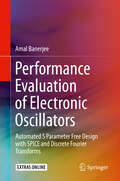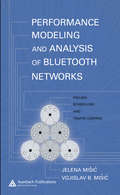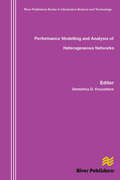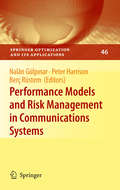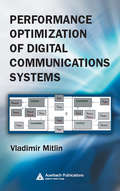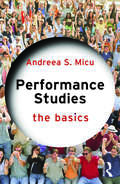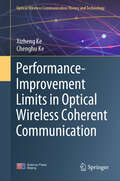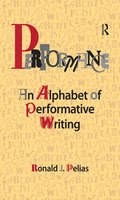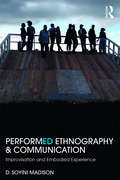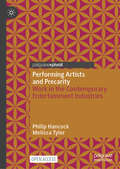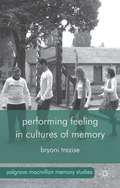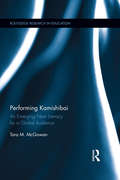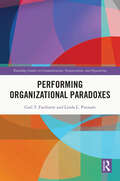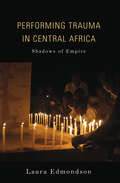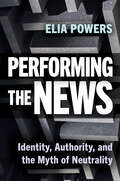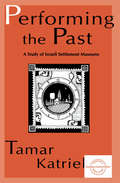- Table View
- List View
Performance Analysis of Cooperative Networking with Multi Channels
by Praveen Kumar Devulapalli Sushanth Babu Maganti Pardhasaradhi PokkunuriThis book covers wireless cooperative communication and advanced communication techniques for research scholars and post-graduate students.Features:• This book will be the reference book for cooperative communication.• It addresses the problems in small-scale cooperative communication.• It presents cooperative routing algorithms for large-scale cooperative networks with the constraint of throughput and transmission time.• It presents energy- efficient transmission approach by making use of multiple radio terminals.• It presents adaptive routing algorithm for large-scale cooperative network under mobility environment.
Performance And Media: Taxonomies For A Changing Field
by David Z. Saltz Sarah Bay-Cheng Jennifer Parker-StarbuckThis timely collaboration by three prominent scholars of media-based performance presents a new model for understanding and analyzing theater and performance created and experienced where time-based, live events, and mediated technologies converge-particularly those works conceived and performed explicitly within the context of contemporary digital culture. Performance and Media introduces readers to the complexity of new media-based performances and how best to understand and contextualize the work. Each author presents a different model for how best to approach this work, while inviting readers to develop their own critical frameworks, i. e. , taxonomies, to analyze both past and emerging performances. Performance and Media capitalizes on the advantages of digital media and online collaborations, while simultaneously creating a responsive and integrated resource for research, scholarship, and teaching. Unlike other monographs or edited collections, this book presents the concept of multiple taxonomies as a model for criticism in a dynamic and rapidly changing field.
Performance Appraisal Phrase Book: The Best Words, Phrases, and Techniques for Performace Reviews
by Corey Sandler Janice KeefeYou'll never struggle with performance appraisals again!Do you dread writing employee performance evaluations? Do you struggle for hours to find just the right words of praise, avoid repetition, and tread the fine line between "constructive" and "criticism"?Performance Appraisal Phrase Book makes it easy for you. Featuring concise sections on how to write the evaluation, handle tricky legal issues, and verbally discuss the evaluation, this book also includes a directory of thousands of words and phrases appropriate for any type of written evaluation.You'll be able to find just the right way to assess:Accuracy and attention to detailQuality of workWork habitsTeamwork and interpersonal skillsTimeliness of workWork attitude With Performance Appraisal Phrase Book at your desk, you'll get through reviews in a snap--and have plenty of time left to accomplish all your other managerial duties.
Performance Art: Education and Practice
by Angeliki AvgitidouPerformance Art: Education and Practice is an introduction to performance art through activities and practice prompts that are framed by seminal moments in the history of the medium as well as the current theoretical discussions surrounding performance. The book begins by introducing the terminology related to performance art and its early history. The basic elements of performance, including the body, objects, space, the public, and the public sphere are approached through thematic and conceptual correlations such as objects as autobiography, body as an expression of gendered identity, performance and the everyday, the augmented body, the archive of performance, and public space as space for intervention. Case studies analysed in each chapter are accompanied by reflective questions and discussion topics. The book proposes a wide range of exercises and comprehensive practice prompts that aim to enhance performance skills, promote experimentation, and encourage an experiential understanding of the theory, history, and concepts relating to performance art. Performance Art: Education and Practice is addressed to students of Fine Arts and Performance Studies from beginner to intermediate level, performance and visual artists who are interested in expanding their knowledge base and creative range, and artist-teachers who are interested in developing their own curriculum and workshop content.
Performance Budgeting for State and Local Government
by Janet M. Kelly William C. RivenbarkProvides a comprehensive theoretical and practical framework for informing budget decisions based on the efficiency and effectiveness of service delivery. The authors enliven the text with references to their original research and personal experiences with performance measurement, citizen satisfaction surveys, and financial management practices. This edition includes increased coverage of cost accounting procedures and of citizen participation in performance management.
Performance Controllable Industrial Wireless Networks (Wireless Networks)
by Haibin Yu Wei Liang Xi Jin Chi Xu Peng Zeng Meng ZhengWith the rapid proliferation of information and communications technology, industrial automation has undergone a sweeping transformation toward intelligent manufacturing. Wireless communication is widely considered to be one of the key technologies enabling intelligent manufacturing. On one hand, deterministic communication with high reliability and low latency is typically required in industrial automation applications. On the other hand, wireless communication in industrial settings is hindered by strictly limited communication resources and many other factors which mainly derive from the shared and error-prone nature of the wireless channels used. The limited communication resources and harsh channel conditions pose considerable challenges for reliable, real-time data transmission in industrial wireless networks. Resource optimization methods are vital to ensuring the deterministic performance of industrial wireless networks. Traditional resource optimization methods adopt the isolated resource optimization methods for each protocol layer, which is inherently local-optimal and leads performance uncontrollable. To focus on “Performance Controllable Industrial Wireless Networks”, this book presents thejoint resource optimization methods across multiple protocol layers for industrial wireless networks; reviews recent, major advances; and discusses the practical implementations of the proposed methods. The joint resource optimization methods discussed here will greatly benefit scientists and researchers in the areas of industrial automation and Industrial Internet of Things. To gain the most from this book, readers should have a fundamental grasp of wireless communication, scheduling theory, and convex optimization.
Performance Engineering: Learning Through Applications Using JMT
by Giuseppe SerazziThis open access book improves the users' skills needed to implement models for performance evaluation of digital infrastructures. Building a model is usually a relatively easy task, but making it an accurate representation of the phenomenon to be reproduced is a completely different matter. It is well-known that to increase the ability to build reliable models it is necessary to accumulate experience. The book addresses this need by presenting a collection of case studies of increasing complexity. Readers are introduced to the modeling process gradually, learning the basic concepts step-by-step as they go through the case studies. Queueing Networks are used to design the models solved with simulation and analytical techniques from the open source Java Modelling Tools (JMT). Among the models analyzed there are systems for optimizing performance, identifying bottlenecks, evaluating the impact of the variability of traffic and service demands, analyzing the effects of synchronization policies in parallel computing. Four case studies derived from real-life scenarios are also presented: a surveillance system, autoscaling load fluctuations, web app workflow simulation, and crowd computing platform. This book serves as a reference tool for graduate and senior-level computer science students in courses of performance evaluation and modeling, as well as for researchers and practitioners.
Performance Evaluation Models for Distributed Service Networks (Studies in Systems, Decision and Control #343)
by Grzegorz Bocewicz Jarosław Pempera Victor ToporkovThis book presents novel approaches to formulate, analyze, and solve problems in the area of distributed service networks, notably based on AI-related methods (parallel/cloud computing, declarative modeling, fuzzy methods). Distributed service networks are an important area of research and applications. The methods presented are meant to integrate both emerging and existing concepts and approaches for different types of production flows through synchronizations. An integration of logistics services (e.g., supply chains and projects portfolios), public and multimodal transport, traffic flow congestion management in ad hoc networks, design of high-performance cloud data centers, and milk-run distribution networks are shown as illustrations for the methods proposed. The book is of interest to researchers and practitioners in computer science, operations management, production control, and related fields.
Performance Evaluation for Network Services, Systems and Protocols
by Stênio FernandesThis book provides a comprehensive view of the methods and approaches for performance evaluation of computer networks. It offers a clear and logical introduction to the topic, covering both fundamental concepts and practical aspects. It enables the reader to answer a series of questions regarding performance evaluation in modern computer networking scenarios, such as ‘What, where, and when to measure?’, ‘Which time scale is more appropriate for a particular measurement and analysis?’, 'Experimentation, simulation or emulation? Why?’, and ‘How do I best design a sound performance evaluation plan?’. The book includes concrete examples and applications in the important aspects of experimentation, simulation and emulation, and analytical modeling, with strong support from the scientific literature. It enables the identification of common shortcomings and highlights where students, researchers, and engineers should focus to conduct sound performance evaluation. This book is a useful guide to advanced undergraduates and graduate students, network engineers, and researchers who plan and design proper performance evaluation of computer networks and services. Previous knowledge of computer networks concepts, mechanisms, and protocols is assumed. Although the book provides a quick review on applied statistics in computer networking, familiarity with basic statistics is an asset. It is suitable for advanced courses on computer networking as well as for more specific courses as a secondary textbook.
Performance Evaluation of Electronic Oscillators: Automated S Parameter Free Design with SPICE and Discrete Fourier Transforms
by Amal BanerjeeThis book demonstrates a novel, efficient and automated scheme to design and evaluate the performance of electronic oscillators, operating at the 100s of Megahertz to 10s of Gigahertz frequencies. The author describes a new oscillator design and performance evaluation scheme that addresses all the issues associated with the traditional S parameter (large, small signal) based oscillator design technique by exploiting the properties of a new breed of RF or microwave transistors, the powerful Discrete Fourier Transform and the SPICE tool's transient analysis. Readers will benefit from an exhaustive set of detailed, step-by-step oscillator (feedback, negative resistance, crystal and differential) design examples, as well as the software tools (C executables) used to create the design examples. Designers will be enabled to eliminate the complexities of the traditional oscillator design/performance evaluation scheme using S (large, small) parameter, resulting in accurate, robust and reliable designs.Describes an efficient, automated oscillator design and performance evaluation scheme that addresses all the challenges associated with the traditional S parameter (large, small signal) based oscillator design;Provides numerous step-by-step design examples, illustrating the details of the new scheme presented;Includes C executables that run on both Linux and Windows, which the reader can use to experiment and design any oscillator (feedback common emitter or base, negative resistance common emitter or base or differential).
Performance Modeling and Analysis of Bluetooth Networks: Polling, Scheduling, and Traffic Control
by Jelena Misic Vojislav B. MisicUntil now, developers and researchers interested in the design, operation, and performance of Bluetooth networks have lacked guidance about potential answers and the relative advantages and disadvantages of performance solutions.Performance Modeling and Analysis of Bluetooth Networks: Polling, Scheduling, and Traffic Control summarizes t
Performance Modelling and Analysis of Heterogeneous Networks (River Publishers Series In Information Science And Technology Ser.)
by Demetres D. KouvatsosOver the recent years, a considerable amount of effort has been devoted, both in industry and academia, towards the performance modelling, evaluation and prediction of convergent multi-service heterogeneous networks, such as wireless and optical networks, towards the design and dimensioning of the next and future generation Internets.This book follows Heterogeneous Networks: Traffic Engineering, Performance Evaluation Studies and Tools and presents recent advances in networks of diverse technology reflecting the state-of-the-art technology and research achievements in performance modelling, analysis and applications worldwide.Technical topics discussed in the book include:• Multiservice Switching Networks;• Multiservice Switching Networks;• Wireless Ad Hoc Networks;• Wireless Sensor Networks;• Wireless Cellular Networks;• Optical Networks;Heterogeneous Networks:- Performance Modelling and Analysis contains recently extended research papers, which have their roots in the series of the HET-NETs International Working Conferences focusing on the 'Performance Modelling and Evaluation of Heterogeneous Networks' under the auspices of the EU Networks of Excellence Euro-NGI and Euro-FGI.Heterogeneous Networks: Performance Modelling and Analysis is ideal for personnel in computer/communication industries as well as academic staff and master/research students in computer science, operational research, electrical engineering and telecommunication systems and the Internet.KeywordsHeterogeneous networks, performance modelling and analysis, wired networks, wireless networks: ad hoc, sensor and cellular, optical networks, next and future generation Internets.
Performance Models and Risk Management in Communications Systems
by Berc Rustem Nalân Gülpınar Peter G. HarrisonThis volume covers recent developments in the design, operation, and management of mobile telecommunication and computer systems. Uncertainty regarding loading and system parameters leads to challenging optimization and robustness issues. Stochastic modeling combined with optimization theory ensures the optimum end-to-end performance of telecommunication or computer network systems. In view of the diverse design options possible, supporting models have many adjustable parameters and choosing the best set for a particular performance objective is delicate and time-consuming. An optimization based approach determines the optimal possible allocation for these parameters. Researchers and graduate students working at the interface of telecommunications and operations research will benefit from this book. Due to the practical approach, this book will also serve as a reference tool for scientists and engineers in telecommunication and computer networks who depend upon optimization.
Performance Optimization of Digital Communications Systems
by Vladimir MitlinBecause fine-tuning the parameters of a system is critical to a developer's success, Performance Optimization of Digital Communications Systems examines particular optimization problems in digital communications, presenting analytical techniques in combination with SystemView and MATLAB simulations.
Performance Studies: The Basics (The Basics)
by Andreea S. MicuPerformance Studies: The Basics offers an overview of the multiple, often overlapping definitions of performance, from performance art, performance as everyday life, and rituals, to the performative dimensions of identity, such as gender, race and sexuality. This book defines the interdisciplinary field of performance studies as it has evolved over the past four decades at the intersection of academic scholarship and artistic and activist practices. It discusses performance as an important means of communicating and of understanding the world, highlighting its intersections with critical theory and arguing for the importance of performance in the study of human behaviour and social practices. Complete with a helpful glossary and bibliography, as well as suggestions for further reading, this book is an ideal starting point for those studying performance studies as well as for general readers with an interest in the subject.
Performance-Improvement Limits in Optical Wireless Coherent Communication (Optical Wireless Communication Theory and Technology)
by Xizheng Ke Chenghu KeThis book presents some of the recent developments in the field of optical-wireless coherence communication. The factors affecting the coherence detection sensitivity are analyzed and the approach to approximate the coherence detection limit is discussed. The wavefront distortion caused by atmospheric turbulence is analyzed, and the influence of the wavefront distortion on the coherence detection performance is examined. A new concept of vortex-beam coherence-detection is proposed, and the problem of signal light decomposition into partially coherent light detection is analyzed. This book can benefit researchers, engineers, and graduate students in the field of telecommunications. It is suitable for engineering and technical personnel engaged in applied optics and communications engineering, university teachers, graduate students, and senior undergraduates.
Performance: An Alphabet of Performative Writing
by Ronald J PeliasPerformance uses the alphabet as an organizational device to present a series of short pieces that approach performance from multiple perspectives and various compositional strategies. Pelias’s essays, poetry, dialogue, personal narratives, quick speculations, and other literary genres explore the key themes in this field, encapsulating the essence of performance studies for the novice and providing food for thought for the expert. Its brief, evocative, and reflexive pieces introduce performative writing as a method of research for those in performance and many other fields.
Performed Ethnography and Communication: Improvisation and Embodied Experience
by D Soyini MadisonPerformed Ethnography and Communication explores the relationships between these three key terms, addressing the impact of ethnography and communication on the cutting edge of performance studies. Ranging from digital performance, improvisation and the body, to fieldwork and staged collaboration, this volume is divided into two main sections: "Embodied technique and practice," which addresses improvisation, devised theatre-making, and body work to consider what makes bodies move, sound, behave, mean, or appear differently, and the effects of these differences on performance; "Oral history and personal narrative performance," which is concerned with the ways personal stories and histories might be transformed into public events, looking at questions of perspective, ownership, and reception. Including specific historical and theoretical case studies, exercises and activities, and practical applications for improvisation, ethnography, and devised and digital performance, Performed Ethnography and Communication represents an invaluable resource for today’s student of performance studies, communication studies or cultural studies.
Performing Artists and Precarity: Work in the Contemporary Entertainment Industries
by Melissa Tyler Philip HancockThis open access book focuses on the distinctive experiences of freelance and self-employed live performers in the UK’s live entertainment industries It provides an in-depth account of their working lives during COVID-19, showing how their experiences of the pandemic provide insight into the different types of precarity shaping what it means to be a live performer. A growing body of academic research has focused on the meaning, experience, and nature of precarity for those working in the cultural and creative sector, highlighting the problem of socio-economic precarity. This book demonstrates how a constant struggle for recognition also shapes the contours and lived experiences of live performance work. It emphasizes how, combined with affective and socio-economic forms of precarity, this recognitive precarity creates a distinctive and challenging set of working conditions. Drawing on original data generated through a national survey of self-employed and freelance performers across the live entertainment industries, combined with insights derived from a series of in-depth semi-structured interviews, this book presents an empirically rich insight into the struggles and opportunities presented by the multiple forms of precarity that the pandemic brought to the fore. It gives voice to a precarious workforce that remains integral to one of the UK’s most economically buoyant sectors but whose experiences are often marginalized in academic research, and in policy and practice. It will, therefore, offer a unique insight for both students and scholars of work and employment, and for those working in the cultural and creative sector, into the distinctive nature of work as a freelance or self-employed live performer.
Performing Feeling in Cultures of Memory
by Bryoni TrezisePerforming Feeling in Cultures of Memory brings memory studies into conversation with a focus on feelings as cultural actors. It charts a series of memory sites that range from canonical museums and memorials, to practices enabled by the virtual terrain of Second Life, popular 'trauma TV' programs and radical theatre practice.
Performing Kamishibai: An Emerging New Literacy for a Global Audience (Routledge Research in Education)
by Tara McGowanKamishibai (paper-theater), a Japanese picture-storytelling medium, is gaining global interest as we move from a text-based culture to one that emphasizes multiple semiotic systems and performance. This is the first volume to explore the potential of kamishibai as a dynamic "new" interactive medium for teaching multimodal communication and shows how synchronizing oral, visual and gestural modes develops students’ awareness of all modes of communication as potential resources in their learning. By examining the multiple modes involved in kamishibai through actual student performances over several venues, this volume overturns commonly held expectations about literacy in the classroom and provides a critical perspective on assumptions about other media. It offers much-needed information about a medium that is attracting interest from educators, academics and artists worldwide.
Performing Organizational Paradoxes (Routledge Studies in Communication, Organization, and Organizing)
by Linda L. Putnam Gail T. FairhurstPerforming Organizational Paradoxes takes a constitutive, process approach to organizational paradoxes. It underscores the performative nature of paradox through underlying dialectical tensions, its sociomaterial foundations, and power features that bring paradoxes to life, sustain them, and enable their transformation. The book first situates a constitutive approach in the extant organizational paradox literature, by broadening the constitutive approach and addressing the many debates and inaccuracies around it. For the novice, several early chapters devote themselves to considering how paradoxical tensions present themselves, invite responses, and interrelate through their organizing outcomes. For the advanced, latter chapters consider the ubiquity of power and paradox, how bodies escape the quarantine of their paradox narratives, how inventive category work can resist power-imbued paradoxes, and an agenda for future research that challenges scholars to do more on the process side of paradox. Filling an important gap in the existing literature, this book will be a key resource for scholars and students in the fields of communication, management, educational administration, organizational psychology and any other fields that study organizations.
Performing Trauma in Central Africa: Shadows of Empire (African Expressive Cultures)
by Laura Edmondson“An outstanding addition to the literature on theatre and performance in situations of conflict and post-conflict.” —New Theatre QuarterlyWhat are the stakes of cultural production in a time of war? How is artistic expression prone to manipulation by the state and international humanitarian organizations? In the charged political terrain of post-genocide Rwanda, post-civil war Uganda, and recent violence in the Democratic Republic of Congo, Laura Edmondson explores performance through the lens of empire.Instead of celebrating theatre productions as expression of cultural agency and resilience, Edmondson traces their humanitarian imperatives to a place where global narratives of violence take precedence over local traditions and audiences. Working at the intersection of performance and trauma, Edmondson reveals how artists and cultural workers manipulate narratives in the shadow of empire and how empire, in turn, infiltrates creative capacities.
Performing the News: Identity, Authority, and the Myth of Neutrality
by Elia PowersPerforming the News: Identity, Authority, and the Myth of Neutrality explores how journalists from historically marginalized groups have long felt pressure to conform when performing for audiences. Many speak with a flat, “neutral” accent, modify their delivery to hide distinctive vocal attributes, dress conventionally to appeal to the “average” viewer, and maintain a consistent appearance to avoid unwanted attention. Their aim is what author Elia Powers refers to as performance neutrality—presentation that is deemed unobjectionable, reveals little about journalists’ social identity, and supposedly does not detract from their message. Increasingly, journalists are challenging restrictive, purportedly neutral forms of self-presentation. This book argues that performance neutrality is a myth that reinforces the status quo, limits on-air diversity, and hinders efforts to make newsrooms more inclusive. Through in-depth interviews with journalists in broadcasting and podcasting, and those who shape their performance, the author suggests ways to make journalism more inclusive and representative of diverse audiences.
Performing the Past: A Study of Israeli Settlement Museums (Everyday Communication Series)
by Tamar KatrielA nostalgic interest in the past is a well-recognized feature of fast-changing, contemporary societies. It finds its expression in a variety of history-making practices of which the establishment of local heritage museums is a major manifestation in many parts of the world today. Katriel develops a communication-centered perspective on the study of heritage museums and -- by extension -- other tourist sites, highlighting the role of discourse in these institutionalized, yet vernacular contexts of cultural production, social legitimation, and identity formation. Descriptive and critical in orientation, this book combines a close analysis of museum discourse with an exploration of such larger issues as: * the socio-cultural role of museums as arenas for the production of collective memory, * the ideological and performative constraints that shape museum presentations, * the interfacing of verbal and visual codes of communication in the context of material displays, * the dialectical interplay of the local and the global in contemporary life, and * the interpenetration of the personal and the communal in vernacular processes of narrative production. Of interest to scholars in communication, linguistics, anthropology, history, museum studies, tourism, intercultural communication, middle eastern studies, or those with interests in narratives, material culture, and ethnography.
